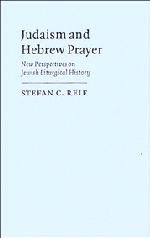Book contents
- Frontmatter
- Contents
- Preface
- 1 On Jewish liturgical research
- 2 The biblical inspiration
- 3 The early liturgy of the synagogue
- 4 Some liturgical issues in the talmudic sources
- 5 How the first Jewish prayer-book evolved
- 6 Authorities, rites and texts in the Middle Ages
- 7 From printed prayers to the spread of pietistic ones
- 8 The challenge of the modern world
- 9 A background to current developments
- Notes
- Select Bibliography
- Index of sources
- Index of prayers and rituals
- Index of names
- Index of subjects and rites
6 - Authorities, rites and texts in the Middle Ages
Published online by Cambridge University Press: 05 February 2015
- Frontmatter
- Contents
- Preface
- 1 On Jewish liturgical research
- 2 The biblical inspiration
- 3 The early liturgy of the synagogue
- 4 Some liturgical issues in the talmudic sources
- 5 How the first Jewish prayer-book evolved
- 6 Authorities, rites and texts in the Middle Ages
- 7 From printed prayers to the spread of pietistic ones
- 8 The challenge of the modern world
- 9 A background to current developments
- Notes
- Select Bibliography
- Index of sources
- Index of prayers and rituals
- Index of names
- Index of subjects and rites
Summary
Moving as we now do to the period that ranges from the embryonic prayer-books of the geonim across some five or six centuries to the earliest printed siddur involves passage through the Middle Ages, an exercise that is always fraught with danger for the historian, whatever aspect of human endeavour he is attempting to chronicle. The sources are never extensive; their interpretation requires a judicious blend of critical detachment and sympathetic understanding; and distinctions must be drawn between their concepts of authority, attribution and transmission and our own. Whatever modern scholars may identify as the dominant idea or the intellectual theory that lies behind a particular development or group of developments, the contemporary practitioner was responding to an immediate and local need within his world of commitments and their motivating ideology. Sometimes the result of his activities was less of a factor in the ultimate turn of events than some more haphazard circumstance such as the survival of a particular volume. Et habent suafata libelli. But the mediaeval period is no longer being seen by historians as the backward, disorderly and obscure hiatus between the classical world and modernity. However little such academic disciplines as theology, law and philosophy currently take account of the Middle Ages, it is becoming progressively clearer that major contributions were then made to these and other fields of intellectual development and that it is partly as a result of the biases of early modern scholarship that they have not been given their due attention.
- Type
- Chapter
- Information
- Judaism and Hebrew PrayerNew Perspectives on Jewish Liturgical History, pp. 153 - 206Publisher: Cambridge University PressPrint publication year: 1993



